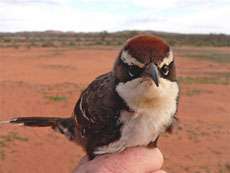Mother's little helpers let her relax

Having relations around to help look after the kids lets mothers ease off and save energy for the next lot, a study of Australian cooperative birds shows.
Published in Behavioral Ecology and Sociobiology, the research shows that mother chestnut-crowned babblers bring food to their chicks much less often when they have family members doing the same.
'We were expecting that mothers would work hardest at feeding their chicks because, on average, they have the greatest genetic stake in their young. But this was not the case,' says Dr Lucy Browning, now of the University of New South Wales, who led the research.
Yet by slacking off on the communal task of feeding, it may be that the mother avoids spending energy and risking predator attack while looking for suitable food. Instead, she can save her energy for her next attempt to breed.
This isn't just relevant to birds; ultimately it could help shed light on how we reproduce and raise children ourselves.

'The breeding female produces all the group's offspring, and the more the others can support her, the higher quality offspring she will produce, which is better for everyone,' says Dr Andy Russell of the University of Exeter, another of the paper's authors. 'So in a small group the breeding female does as much as anyone else, but we found that as the group gets larger she reduces her feeding activity by about two thirds.'
The researchers monitored numerous groups of babblers at the University of New South Wales Arid Zone Research Station throughout the process of rearing young. They tracked the size of prey that each adult brought the chicks, what kind of food it was and how often they did it.
Chestnut-crowned babblers are what ecologists call 'obligate cooperative breeders' - they breed in family groups, in which only the dominant pair ever get to produce the offspring, and breeding without help is rare and generally unsuccessful. The other birds have to content themselves with helping their relations raise their chicks, and hoping to improve the chances of their genes getting passed on to the next generation that way. Bringing prey for the youngsters to eat is a big part of this.
This means breeding female babblers don't just have their mate to help take care of their chicks, but also numerous grown-up offspring and other relations. So they can put less effort in without significantly adding to the risk their offspring will starve. Flying about looking for food is tiring, and exposes mothers to the risk of attack by hawks and falcons. And the whole process of breeding is hard work for females; they have to lay eggs and stay sitting on them until they hatch.
So in theory it makes sense that mothers should put less effort into feeding chicks when there are others to do that. But this is one of the first times scientists have shown such a clear pattern for the breeding female alone.
Males may scale back their feeding contributions a little, but there's less reason for them to slack off as they invest much less in each attempt at breeding. They don't have to lay eggs or spend weeks incubating them, so there's less incentive to try to conserve as much energy as possible for the next breeding attempt. Meanwhile the females generally brought large items of prey, but much less often. This increased prey size didn't come close to counterbalancing the drop in how often they brought food.
Russell says that similar group cooperation could have played an important role in the development of human reproduction as we know it. People have an unusually short birth interval compared to with primates of a similar size - women can have another child only another year or so after their last one, compared to about five years in chimpanzees. 'In humans, grannies, siblings and older children provide mothers with a huge amount of support,' he says. 'It's likely that our short birth interval evolved as a consequence of this kind of helping behaviour, which allowed mothers to reduce their investment of energy in their current child in order to prepare for the next one.'
The behaviour is subtly different from that of other obligate cooperative breeders like meerkats; there, both parents significantly reduce their investment in feeding young, not just the mother. Another recent paper by the same team showed that the chestnut-crowned babblers don't just share the burden of child-rearing; they are honest about always feeding the food they bring to the young, even when they're hidden inside the domed nest and could easily just eat it themselves.
More information: Browning, L.E., Young C.M., Savage J.L., Griffith S.C. & Russell A.F. (2012) Carer provisioning rules in an obligate cooperative breeder: prey type, size and delivery rate. Behavioral Ecology & Sociobiology.
Journal information: Behavioral Ecology and Sociobiology
Provided by PlanetEarth Online



















